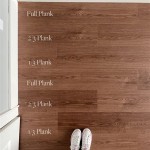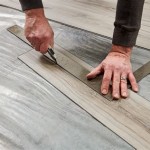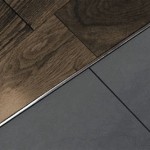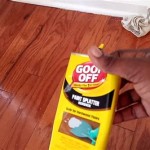How to Remove Super Glue From Wooden Floors
Super glue, also known as cyanoacrylate adhesive, is renowned for its rapid bonding and strong hold. Its widespread use in households and workshops makes accidental spills onto various surfaces, including wooden floors, a common occurrence. Removing super glue from wooden floors requires a careful approach to avoid damaging the wood's finish or the wood itself. This article provides a detailed, step-by-step guide on effectively removing super glue from wooden floors, outlining various methods and precautions to ensure a successful outcome.
The initial approach to removing super glue should prioritize methods that minimize the risk of abrasion or chemical damage to the wood. The specific method employed often depends on the type of wood flooring (e.g., hardwood, laminate, engineered wood), the finish applied (e.g., polyurethane, varnish, oil), and the size and age of the super glue spill. It's always advisable to test any cleaning solution or removal technique in an inconspicuous area first to assess its impact on the floor's finish.
Softening the Super Glue
The primary principle behind removing super glue is to weaken its bond with the wooden surface. This can be achieved through various means, primarily by softening the hardened adhesive. The following methods detail how to achieve this softening effect, making the glue more pliable and easier to remove.
Acetone (Nail Polish Remover): Acetone is a common solvent effective in dissolving cyanoacrylate adhesives. However, it is crucial to use it with caution, particularly on floors with a delicate finish. To use acetone, first, ensure proper ventilation by opening windows or using a fan. Apply a small amount of acetone to a clean cotton ball or soft cloth. Gently dab the super glue stain, avoiding excessive rubbing which could spread the glue or damage the surrounding finish. Allow the acetone to sit on the glue for a few minutes to soften it. After softening, gently scrape the glue away with a plastic scraper or the edge of a credit card. Repeat the process as needed, being careful not to saturate the wood with acetone. Once the glue is removed, wipe the area with a clean, damp cloth to remove any acetone residue and then dry thoroughly.
Warm Water and Soap: In some instances, especially with fresh spills, warm soapy water can be sufficient to loosen the super glue. Mix a mild dish soap with warm water. Soak a clean cloth in the solution and place it over the glue stain. Allow the wet cloth to sit for 15-30 minutes to soften the glue. After soaking, try gently scraping away the glue with a plastic scraper. This method is less aggressive than acetone and is a good starting point to minimize the risk of damage. Repeat as needed.
Cooking Oil or Mineral Oil: Oils can help to penetrate and weaken the super glue bond. Apply a small amount of cooking oil (such as olive oil, vegetable oil, or canola oil) or mineral oil directly onto the super glue stain. Let the oil sit for several hours, or even overnight, to allow it to seep into the glue. After soaking, use a plastic scraper to gently lift the softened glue. Wipe the area with a clean, damp cloth to remove any oil residue. This method is generally safe for most wood finishes, but it's always best to test it in an inconspicuous area first.
Heat (Hair Dryer): Applying heat can soften the super glue, making it easier to remove. Use a hair dryer set on a low heat setting. Hold the hair dryer a few inches away from the glue stain and direct the heat onto the glue for a few minutes. This helps to soften the adhesive bond. After heating, try gently scraping the glue away with a plastic scraper. Be cautious not to overheat the area, as excessive heat can damage the wood finish.
Scraping Away the Glue
After softening the super glue, the next step involves carefully scraping it away from the wooden floor. This requires using the appropriate tools and techniques to avoid scratching or gouging the surface.
Plastic Scraper or Credit Card: These tools are ideal for removing softened super glue without damaging the wood finish. Gently slide the edge of the scraper or card under the softened glue and lift it away. Work slowly and patiently, applying gentle pressure. Avoid using metal scrapers or sharp objects, as they can easily scratch the wood. Regularly clean the scraper to prevent transferring loosened glue back onto the floor.
Wooden or Bamboo Skewer: A wooden or bamboo skewer can be useful for removing glue from smaller areas or intricate patterns in the wood. Its softer nature compared to metal reduces the risk of scratches. Use the pointed end of the skewer to gently loosen the edges of the glue and then lift it away. Be careful not to apply excessive pressure that could dent or chip the wood.
Soft Cloth or Sponge: After scraping away the bulk of the super glue, use a soft cloth or sponge to remove any remaining residue. Dampen the cloth or sponge with warm water and gently wipe the area. Avoid using abrasive pads or scrub brushes, as they can scratch the finish. For stubborn residue, a mild solution of dish soap and water can be used.
Patience and Persistence: Removing super glue can be a time-consuming process, especially for larger or older spills. It's important to be patient and persistent, repeating the softening and scraping steps as needed until the glue is completely removed. Avoid rushing the process or using excessive force, as this can increase the risk of damage.
Addressing Remaining Residue and Repairing Damage
Even after successfully removing the bulk of the super glue, there may be some remaining residue or slight damage to the floor's finish. This section details how to address these issues and restore the wood floor to its original condition.
Mineral Spirits or Denatured Alcohol: For stubborn glue residue, mineral spirits or denatured alcohol can be used. Apply a small amount to a clean cloth and gently wipe the affected area. These solvents are stronger than acetone but should still be used with caution. Test in an inconspicuous area first. Follow up with a clean, damp cloth to remove any solvent residue. Ensure the area is well-ventilated during and after application.
Fine-Grit Sandpaper (If Necessary): If the super glue has damaged the floor's finish, light sanding may be necessary. Use a very fine-grit sandpaper (e.g., 400-grit or higher) to gently sand the affected area. Sand in the direction of the wood grain to avoid creating visible scratches. Remove any sanding dust with a tack cloth before proceeding.
Touch-Up Finish: After sanding, the area will likely need to be refinished to match the surrounding floor. Use a wood finish that matches the original finish of the floor (e.g., polyurethane, varnish, oil). Apply the finish according to the manufacturer's instructions. Multiple thin coats may be preferable to one thick coat for a smoother, more even finish. Allow each coat to dry completely before applying the next. Consider consulting a professional for help with matching the finish and applying it correctly.
Wood Filler (For Minor Damage): If the super glue has chipped or gouged the wood, wood filler can be used to repair the damage. Clean the area thoroughly and apply wood filler that matches the color of the wood. Allow the filler to dry completely and then sand it smooth with fine-grit sandpaper. Apply a touch-up finish to blend the repaired area with the surrounding floor.
Preventive Measures: After successfully removing the super glue, consider taking preventive measures to avoid future spills. Use a drop cloth or protective covering when working with super glue near wooden floors. Store super glue in a secure location away from areas where it could easily spill. Clean up any spills immediately to prevent them from hardening and becoming more difficult to remove.
Removing super glue from wooden floors requires patience, care, and the use of appropriate techniques. By following the steps outlined in this article, individuals can effectively remove super glue stains while minimizing the risk of damage to the floor. Always prioritize gentle methods and test any cleaning solutions or techniques in an inconspicuous area first. When in doubt, consult a professional floor cleaning or repair service for assistance.

How To Remove Super Glue From Laminate Flooring 14 Steps

Removing Glue Or Adhesive From Hardwood Floors The Speckled Goat

4 Ways To Remove Glue From Wood Wikihow

Removing Glue Or Adhesive From Hardwood Floors The Speckled Goat

4 Ways To Remove Glue From Wood Wikihow

Remove Super Glue From Hardwood Flooring

How To Remove Super Glue From Skin On

Removing Glue Or Adhesive From Hardwood Floors The Speckled Goat

How To Remove Glue From Wooden Floors A Helpful Guide

Floor Glue Clean Howto Luxuryvinylplank Pvc Tiktok
See Also







